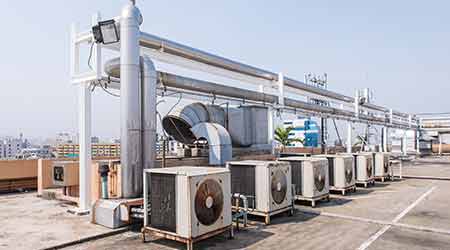Avoiding Roof Replacement Problems
Part one of a four-part article on roof replacements
One of the most challenging aspects of managing an institutional or commercial facility is addressing roofing issues. For many maintenance and engineering managers, roofs frequently are problems from the day they are installed.
One immense issue is that roofs are not the easiest components to maintain. Correcting a problem in one area seems to generate a new issue in another area. Replacing a roof is a big-ticket investment, not to mention disruptive, and they do not improve with age. In fact, nearly one-half of all roofs require replacement before they reach their rated service lives.
Eventually, all roof systems require replacement. The success of the replacement project depends to a great extent on actions that managers take before and during the replacement process. While many issues can contribute to a less-than-successful replacement project, managers need to be aware of the four of the most common problems.
Waiting until later
The usual approach to roof replacement project is to wait until a major issue arises, such as a membrane failure or a major leak, to start the planning process. The problem with this approach is that roofs rarely fail suddenly. They deteriorate over a long period.
Managers and front-line technicians can take steps to detect problems early and track deterioration. Roofs send signals as they go bad. Membranes move, seams split, surfaces alligator, flashing lifts and water leaks. All of these symptoms are warning signs that something is going wrong with the roofing system, and that something is almost always bad. Most problems are easy to find. All technicians need to do is look closely.
Managers should schedule regular roof inspections to be conducted by a qualified individual. If in-house expertise is not available, the manager should contract with an outside roofing inspector. Ideally, this person will complete two inspections each year — one in the fall after the roof has been exposed to the harsh temperatures of summer and once in the spring to check for damage from snow and ice.
By tracking the inspections over time, managers can develop a feel for the way their roofs are performing and the rate at which they are deteriorating. Accelerating deterioration and growing repair requirements are two signs the roof is nearing the end of its service life. Just because a roof has shown no major problems does not mean managers should put off replacement. If a 20-year roof is only 15 years old, it does not mean managers should wait another five years or more before making plans for replacement. The replacement schedule must reflect the actual condition of the roof.
Choosing to replace the roof before it actually fails might seem like a waste of money. In fact, this option can save money. When roofs fail, the results can be extensive damage to the building interior. Replacing a roof before it actually fails and wreaks havoc inside a facility can enable managers to avoid damage repair costs.
One additional benefit of replacing a roof before it actually fails is that by picking the time for replacement, a manager can schedule the project for a time that best suits the department’s workload and the facility’s activities. Effective scheduling also allows managers to evaluate their roofing options properly, prepare specifications, and select a qualified installer.
Related Topics:















